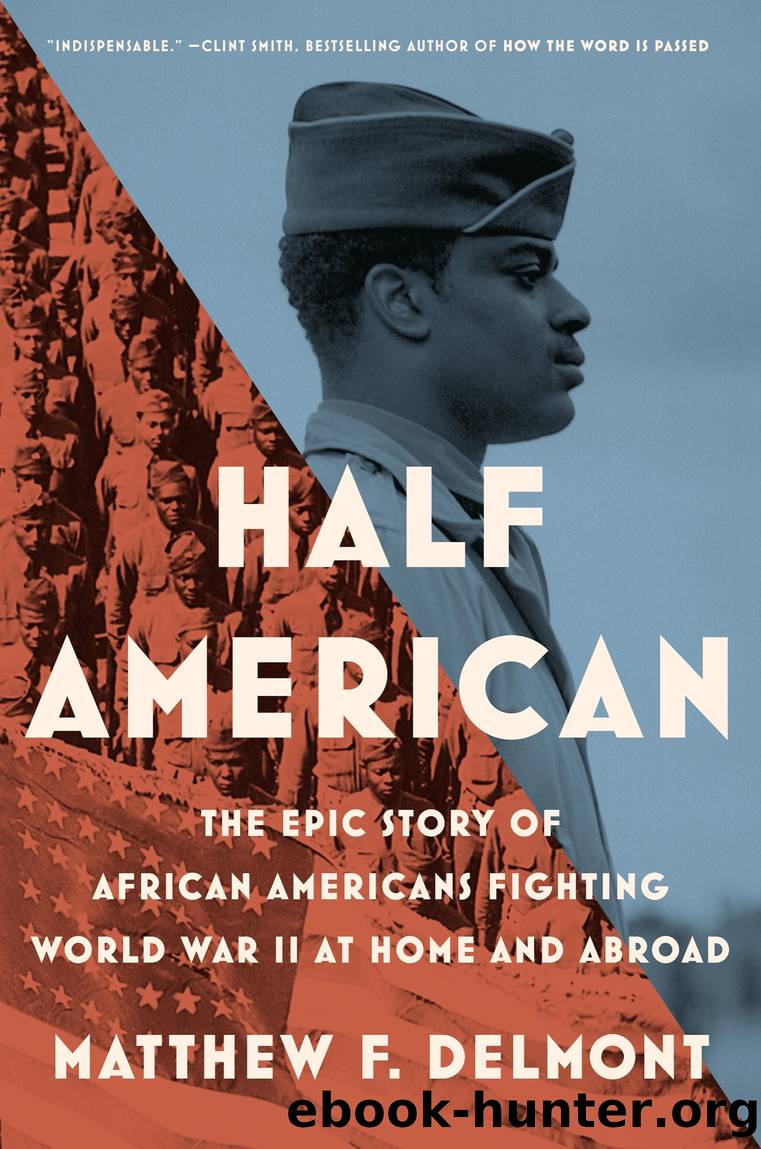Half American: the Epic Story of African Americans Fighting World War II at Home and Abroad by Matthew F. Delmont

Author:Matthew F. Delmont [Delmont, Matthew F.]
Language: eng
Format: epub
Publisher: Penguin Publishing Group
Published: 2022-10-18T00:00:00+00:00
* * *
â
Port Chicago was just one of several cases of Black military personnel protesting discriminatory treatment. Like sailors loading ammunition, the 12,500 Black Seabees (Naval Construction Battalion personnel) did important work for the navy. They built advanced bases, constructed underwater slips for naval vessels, and off-loaded cargo. Like other Black military laborers, they worked under white officers. A thousand Black Seabees, who had served nearly two years overseas in Tulagi and Guadalcanal in the Pacific theater, staged a hunger strike at Camp Rousseau in Port Hueneme, California, after their commanding officer refused to promote Black Americans and assigned Black Seabees only to unskilled manual labor. âIt is discouraging and destructive to the morale when they see white men with much less preparation than they have, and with no more apparent qualifications of leadership than they possess, being advanced beyond them,â NAACP secretary Roy Wilkins said. Nineteen of the Seabees were discharged for seditious behavior.
At Freeman Army Airfield, in Indiana, over a hundred Tuskegee Airmen officers were arrested when they attempted to integrate an all-white Officersâ Club. âIâd flown sixty-seven combat missions in Europe,â Lieutenant Colonel Clarence Jamison recalled. âAs an officer of the United States Army Air Corps, whoâd put his life on the line for this country, why couldnât I use a United States Army Officers club?â The Black pilots had endured racism at Tuskegee, from segregated bathrooms on base to violence at the hands of police in town. They had risked their lives and lost friends fighting for a country that treated them as less valuable than white citizens. Now they were fed up. Their protest happened to take place at an Officersâ Club, but it was about much more than that. âIt was a slap in the face,â Jamison said. âIt defiled the graves of [Black pilots] . . . whoâd made the ultimate sacrifice for their country but couldnât get into a dive club because of their skin color.â
At Fort Devens, in Massachusetts, over fifty Black women went on strike to protest racial discrimination in the Womenâs Army Corps. Many of the women were college graduates and were enticed to enlist in the WAC by promises of skilled jobs, only to be assigned cleaning duty. Alice Young, a twenty-three-year-old from Washington, D.C., who left nursing school to join the WAC, recalled that her hospital commander told her, âI do not have colored WACs as medical technicians. They are here to scrub and wash floors, wash dishes and do all the dirty work.â The four strike leadersâMary Green, Anna Morrison, Johnnie Murphy, and Youngâwere court-martialed. âIf it will help my people by me taking a court-martial, I would be willing to take it,â Morrison said in her court testimony.
Hundreds of other Black soldiers and sailors staged their own individual protests, refusing to obey racially unjust orders from officers, military police, and local sheriffs. Among them, Lieutenant Jackie Robinson was court-martialed at Camp Hood, Texas, in the summer of 1944 when he refused to move to a seat in the back of an army bus.
Download
This site does not store any files on its server. We only index and link to content provided by other sites. Please contact the content providers to delete copyright contents if any and email us, we'll remove relevant links or contents immediately.
| Americas | African Americans |
| Civil War | Colonial Period |
| Immigrants | Revolution & Founding |
| State & Local |
In Cold Blood by Truman Capote(3311)
The Innovators: How a Group of Hackers, Geniuses, and Geeks Created the Digital Revolution by Walter Isaacson(2849)
Steve Jobs by Walter Isaacson(2837)
All the President's Men by Carl Bernstein & Bob Woodward(2331)
Lonely Planet New York City by Lonely Planet(2173)
And the Band Played On by Randy Shilts(2131)
The Room Where It Happened by John Bolton;(2105)
The Poisoner's Handbook by Deborah Blum(2094)
The Murder of Marilyn Monroe by Jay Margolis(2059)
The Innovators by Walter Isaacson(2057)
Lincoln by David Herbert Donald(1948)
A Colony in a Nation by Chris Hayes(1881)
Under the Banner of Heaven: A Story of Violent Faith by Jon Krakauer(1750)
Amelia Earhart by Doris L. Rich(1650)
The Unsettlers by Mark Sundeen(1647)
Being George Washington by Beck Glenn(1628)
Birdmen by Lawrence Goldstone(1621)
Dirt by Bill Buford(1613)
Zeitoun by Dave Eggers(1594)
